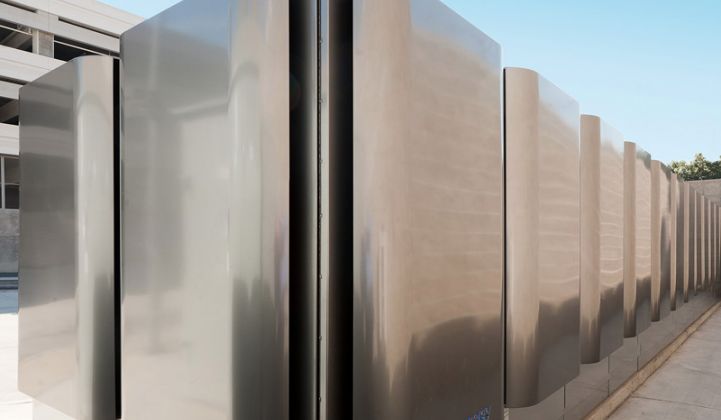Bloom Energy reported fourth-quarter 2018 revenues of $213.6 million on Tuesday after market close. That’s up from $190 million in the previous quarter, up 73 percent year-over-year — and above analyst estimates.
The Sunnyvale, Calif.-based solid-oxide fuel cell firm reported earnings per share of ($0.12), besting consensus of ($0.18) for the quarter. Adjusted net loss per share for 2018 of ($0.63) was in line with estimates. Bloom lost $99.8 million in the fourth quarter of 2018 — and CFO Randy Furr said he expects continued losses in Q1 2019 during today's earnings call. The fuel cell leader lost $242 million for the year, slightly less than the $263 million lost in 2017.
Bloom's total revenue for 2018 was $742 million, almost double last year’s figure. Growth was driven by the reinstatement of the federal Investment Tax Credit and Bloom's efforts at geographical diversification.
Bloom CEO K.R. Sridhar noted, in a shareholder letter, that the firm’s product and installation backlog was nearing 1,400 systems at year's end, amounting to “70 percent more systems than we deployed in the whole of 2018.”
Record number of fuel cell "acceptances"
Bloom had more positive news: The fuel cell manufacturer reported a total of 809 “acceptances” of its 100-kilowatt units in 2018, a jump of 30 percent over the 622 units accepted in 2017. GAAP gross margin for the year improved to 16 percent and the company showed positive EBITDA.
CEO Sridhar noted that Bloom had reached 257 acceptances in the quarter, a record for the firm and a 27.9 percent jump from the same quarter last year.
He said that the company is making good progress in its strategy to diversify across industry sectors and geographies with growth in powering data centers, health care infrastructure and at utilities. Bloom has closed new business in Japan and continues to foster partnerships in Korea, moving away from its California-centric history.
Bloom factoid: The Bloom fuel cell manufacturing site at the University of Delaware STAR Campus is on the grounds of an old Chrysler plant where Bob Marley once worked.
Optimistic on 2019 margin and growth
Bloom was limited in the extent of its guidance for 2019, but the firm called for a Q1 range of 215 to 245 acceptances for 100-kilowatt fuel cell units, with an average selling price of $6,750 to $7,050 and a total installed system cost of $5,600 to $5,900 — both expressed in dollars per kilowatt. This is roughly six times the capital cost of a combined cycle gas turbine, with roughly similar greenhouse gas emissions.
The CEO said he expects 2019 revenue growth in the "mid-20 percentage points" with gross margins in "the mid-20s" in the second half of 2019. Sridhar is aiming for "30 percent revenue growth and 30 percent gross margins," continued momentum in Korea and an increase in its sales and marketing efforts.
He spoke of an increase in R&D spending in order to drive cost reduction as part of the company's new "7.5 program." Bloom aims for 50 percent more power in the same physical footprint as the current fuel-cell generation, in what the CEO called "a step-change in product cost-down trajectory.”
Sridhar also spoke of more R&D investment for biogas fuels. At the moment Bloom servers require clean methane, whereas utilizing biogas from landfills presents a full set of expensive challenges to fuel cell operation.
Fuel cell stocks were clobbered in 2018: Ballard, Bloom and Plug Power shares dropped by 23 percent, 34 percent and 48 percent, respectively, according S&P Global Market Intelligence.
On its first day as a public company, Bloom shares opened at $18.70 and jumped 25 percent to close at $25. At the time of publication, Bloom's stock was holding steady on this quarter's earnings news at $10.74 per share.




